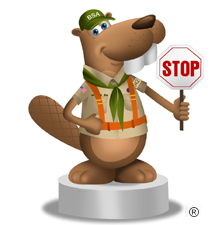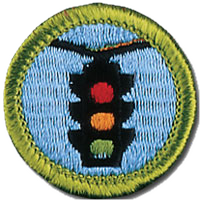Traffic Safety


Resources
- Traffic Safety Merit Badge Pamphlet
- Traffic Safety Merit Badge Class Preparation Page
- Traffic Safety Merit Badge Workbook
- Scoutmaster Bucky's Merit Badge Advancement Quick Reference
- Scoutmaster Bucky's Acknowledgement Form
Traffic Safety Requirements
Current Scouts BSA requirements
as of December 6, 2025
as of December 6, 2025
1.
Do the following:
a.
Describe the top 10 mistakes new drivers frequently make. Name the two
items you are required by law to carry with you whenever you operate a
motor vehicle.
b.
Describe how alcohol and other drugs affect the human body and why a
person should never drink and drive, or drive while under the influence
of any mind-altering substances, including prescription drugs, cold
medications, and illicit drugs. For the state where you live, find out
what is the legal blood alcohol concentration and the consequences for
driving while intoxicated or driving under the influence. Find out what
the open-container law is in your state.
c.
Explain why new drivers are at a significantly higher risk of being
involved in a collision than other drivers and name three (3) steps you
can take that will reduce this risk.
d.
Explain why a driver who is fatigued or distracted should not operate a
motor vehicle. List five common distractions, explain how driver
distractions contribute to traffic accidents, and tell how drivers can
minimize distractions. Describe how volunteer drivers can plan to be
alert when transporting Scouting participants.
2.
Do the following:
a.
Demonstrate how to wear a lap and shoulder belt properly. Explain why
it is important for the driver and all passengers always to wear their
seat belts.
b.
List five safety features found in motor vehicles besides occupant
restraint systems. Describe each safety feature, how each works, and
how each contributes to safety.
3.
Do the following:
a.
Using a vehicle that you have access to, demonstrate that all marker
lights, parking lights, brake lights, turn signals, and headlights are
clear and operational. Explain when you would use these lights, where
the switches are to operate these lights and how these lights
contribute to safe and courteous driving.
b.
Using a vehicle that you have access to, demonstrate how to check the
vehicle's tire pressure and where to locate the correct tire pressure
rating. Explain why proper tire pressure is important to the safe
operation and fuel economy of the vehicle.
c.
Explain why proper tire tread depth is important to safe driving. On
the same vehicle you checked the tire pressure on, demonstrate a method
to check for adequate tire tread depth.
d.
Explain issues that might affect the driver's ability to see through
the front, rear, and side windows. Demonstrate with a smear-and-clear
test if the windshield wiper blades will clear the windshield
completely or need to be replaced. Describe instances in good and bad
weather when windshield wipers are important to safe driving.
4.
Do the following:
a.
In a location away from traffic hazards, measure with a tape
measure—not in a car—and mark off with stakes the distance that a
car will travel during the time needed for decision and reaction,
and the braking distances necessary to stop a car traveling 30, 50,
and 70 miles per hour on dry, level pavement. Discuss how
environmental factors such as bad weather and road conditions will
affect the distance.
b.
As a driver, describe the difference in nighttime visibility between a
properly lit bicycle and rider (or a pedestrian) wearing reflective
material and a bicycle and rider with no lights (or a pedestrian)
dressed in dark clothing, without reflective material.
c.
Explain how color and shape are used to help road users recognize and
understand the information presented on traffic and roadway signs.
Explain the purpose of different types of signs, signals, and pavement
markings.
d.
Describe at least three examples of traffic laws that apply to drivers
of motor vehicles and that bicyclists must also obey.
5.
Do ONE of the following:
a.
Interview a traffic law enforcement officer in your community to
identify what three traffic safety problems the officer is most
concerned about. Discuss with your counselor possible ways to solve one
of those problems.
b.
Write a personal traffic safety pledge, addressing three (3) of your
most concerning issues relating to traffic safety. Show your pledge to
your counselor and discuss your commitment to traffic safety.
c.
Initiate and organize an activity or event to demonstrate the
importance of traffic safety.